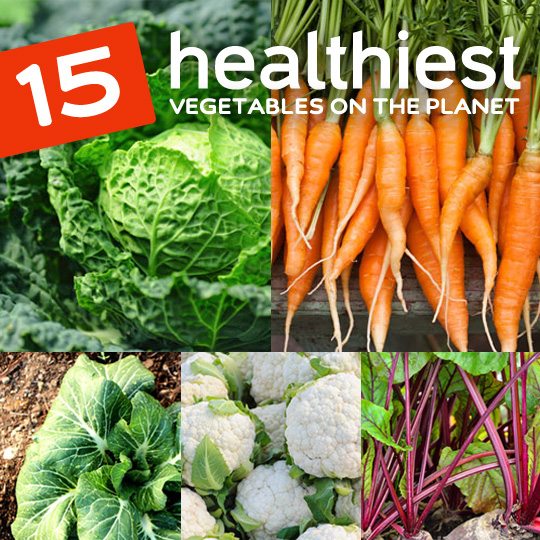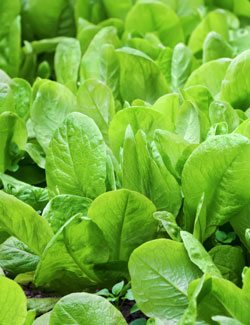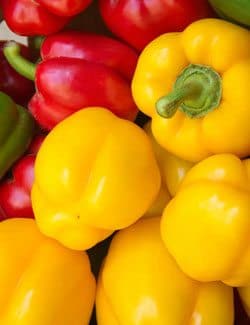

Vegetables have long been regarded as healthy food, but which stand alone at the top as the healthiest vegetables and should make regular plate appearances? We’ve broken down the best of the best and presented them to you here.
[hr]
[column size=”one-third”] [/column]
[/column]
[column size=”two-third” last=”true”]
1. Kale
Kale has emerged as one of the trendiest vegetables in recent years, and it’s not by accident. This is one green vegetable that has been largely overlooked, but now is getting the attention it deserves. A quick rundown of its nutrition profile reveals why it gets so much fanfare.
Like spinach, kale is a good source of phytonutrients and has an antioxidant effect on the body. And like spinach it also provide protein and fiber, containing roughly the same amount of fiber, but besting spinach by offering more protein.
And while both kale and spinach have massive amounts of Vitamin A, kale contains even more, meaning you can eat less kale and still get the same amount of this powerful vitamin.
Best ways to prepare it: Unless you’re using baby kale you’ll want to cook your kale before eating it to avoid stomach upset. It’s also a good idea to remove it from the stems, as those can be hard to digest.[/column]
[hr]
[column size=”one-third”] [/column]
[/column]
[column size=”two-third” last=”true”]
2. Spinach
Spinach has long been considered one of the healthiest vegetables you can eat, and it still remains near the top of the list.
You not only get fiber and protein when you opt for a serving of spinach, you’re getting phytonutrients that act as antioxidants once consumed, and go to work within the body to fight free radical damage.
Spinach is an exceptional source of both Vitamin A and Vitamin C, and provides an assortment of important minerals like potassium, magnesium, calcium, and iron. Rather than take a synthetic multivitamin that the body has trouble absorbing, why not eat spinach and have your nutritional bases covered with a whole food that the body has no problem with and is craving?
Best ways to prepare it: Baby spinach tastes great as the base of a salad, but you can also heat up frozen organic spinach for use as a side, or as part of a main dish. Any form of spinach can be added to a green smoothie for an instant vitamin boost.[/column]
[hr]
[column size=”one-third”] [/column]
[/column]
[column size=”two-third” last=”true”]
3. Broccoli
Broccoli is another vegetable with the status of being ultra healthy, and there’s a lot of research that backs up its reputation. It’s always nice when science lends its support to something we’ve always known intrinsically for years.
Perhaps the biggest benefit of broccoli is its noted ability to ward off cancer thanks to the sulforaphane it contains. It’s also good for your heart, and can help prevent heart disease. Cancer and heart disease are two of the leading causes of death, so it’s important to take steps to maintain your health now.
The fiber in broccoli is worth noting, as it helps the digestive system function properly, helps keep your cholesterol at a healthy level, and can even help keep your colon clean naturally.
Best ways to prepare it: There are tons of ways to get broccoli ready to eat, and one of the more delicious ways is to roast it with a little olive oil. Pair it with another vegetable on this list like beets of Brussels sprouts to boost the flavor and the nutrition.[/column]
[hr]
[column size=”one-third”] [/column]
[/column]
[column size=”two-third” last=”true”]
4. Beets
Beets are becoming better known for the nutrition they provide, especially since antioxidants have been making so many health news headlines. There’s a powerful antioxidant known as betalains that is almost exclusive to beets.
Betalains are most notable for their ability to curb inflammation in the body, and as such they can help prevent cancer, keep your cardiovascular system functioning properly, and reduce the symptoms of arthritis.
In addition to the betalains beets contain, they are also a wonderful source of fiber, which helps maintain good blood pressure levels, and keeps the digestive system humming along.
Best ways to prepare it: Avoid the pickled beets you’ll find on store shelves and opt instead for fresh beets. Cut them up and place the cubes on a baking dish. Bake them in the oven until they’ve softened and you’re ready for a treat.[/column]
[hr]
[column size=”one-third”] [/column]
[/column]
[column size=”two-third” last=”true”]
5. Cabbage
Cabbage is one vegetable that you’ll often see on diet plans for its ability to spur weight loss. But it has plenty of other healthy benefits to it that make it a vegetable you’ll want to add to your cart regularly.
A cruciferous vegetable, cabbage has anti-cancer properties, for men it can help prevent prostate cancer, and for women it has been shown to help ward off breast cancer, making it an especially valuable vegetable for those with a family history of these diseases.
The naturally low number of calories in cabbage, coupled with its low fat content is what makes it such a darling for those looking to get to a healthy weight. It’s a way to get fiber and vitamins without adding much to your total caloric intake for the day.
Best ways to prepare it: Making cabbage appetizing is the key to eating more of it. If you’ve had multiple instances of eating poorly cooked cabbage, you may want to give it another chance in a proper recipe. You want it soft enough to be easily chewed up, but no so soft as to make it mushy and bland. Accompanying spices and seasonings make all the difference.[/column]
[hr]
[column size=”one-third”] [/column]
[/column]
[column size=”two-third” last=”true”]
6. Asparagus
The cleansing effect of asparagus is what earns it a spot on our list of healthiest veggies. This is a well-rounded vegetable that brings many important vitamins to the body, all while helping it purge itself of destructive free radicals we all take in.
The glutathione in asparagus is what helps the body detox, and it’s an antioxidant that specifically goes after cancer-causing substances in the body, and helps it on a cellular level.
Asparagus also contains a broad range of vitamins and minerals, although not in lopsided amounts like some of the other vegetables on our list. Eat asparagus to top up on vitamins A and C as well as iron and fiber.
Best ways to prepare it: Asparagus is best enjoyed in the spring, which is also the great time to cleanse the body after a long winter. It can be eaten fresh, and maintains a crispy snap that will jazz up any salad. It can also be grilled during the summer alongside a lean protein.[/column]
[hr]
[column size=”one-third”] [/column]
[/column]
[column size=”two-third” last=”true”]
7. Tomatoes
Tomatoes are worth getting excited about because of their strong anti-cancer properties from the lycopene they contain. There’s also some key vitamin support with vitamins like Vitamin K adding to the equation.
This same lycopene also benefits you by providing help for diabetes, heart disease, osteoporosis, and even infertility. It’s also been noted for its ability to fight premature aging of the skin thanks to its antioxidant nature and ability to fight free radical damage.
Lycopene is not all that tomatoes offer, and you’ll be getting sufficient amounts of Vitamin A and Vitamin C, along with some fiber and potassium.
Best ways to prepare it: To release the most lycopene be sure to cook your tomatoes rather than eat them raw. The cooking process drastically increases the amount of lycopene you’ll be able to absorb, thus boosting the amount of benefits you’ll get from eating tomatoes.[/column]
[hr]
[column size=”one-third”] [/column]
[/column]
[column size=”two-third” last=”true”]
8. Brussels Sprouts
Brussels sprouts may not make it on the list of tastiest vegetables, but they have a lot to offer in terms of nutrition, so it may be high time to give them another chance. Go with fresh, organic Brussels sprouts whenever possible for the best taste.
The greatest thing about eating Brussels sprouts is the amount of Vitamin C they contain. In a head to head showdown with an orange, the stereotypical powerhouse of Vitamin C, Brussels sprouts provide more than one and a half times the amount of this immune system booster.
Brussels sprouts are a cruciferous vegetable like kale, spinach, cabbage, and cauliflower, and provide many of the same key nutrients. They are an excellent source of fiber, and also contain minerals like potassium, iron, and magnesium.
Best ways to prepare it: Brussels sprouts taste amazing roasted, so by them fresh, drizzle some olive oil over them, add some balsamic vinaigrette as an option, and bake them until tender.[/column]
[hr]
[column size=”one-third”] [/column]
[/column]
[column size=”two-third” last=”true”]
9. Sweet Potatoes
Sweet potatoes have been recommended by many health experts as a better choice than white potatoes for the antioxidants and fiber they contain.
They have a bright orange color which is a clue that they’re full of beta-Carotene, much like a carrot. This will be converted to Vitamin A by the body, and you don’t have to be concerned that one serving of sweet potato provides far more than the daily recommended supply of Vitamin A. Taking large doses of synthetic forms of Vitamin A poses a health risk, not natural sources like a sweet potato.
Eating a sweet potato is a great way to boost your fiber, as well as your potassium and Vitamin B-6 levels. It’s no slouch in the nutrient department and does make a suitable replacement for potatoes in most recipes.
Best ways to prepare it: A baked sweet potato is one of the easiest side dishes to prepare, and it serves as a satisfying addition to most any protein like chicken, beef, or fish. Or try them mashed as a more nutritious alternative to mashed potatoes.[/column]
[hr]
[column size=”one-third”] [/column]
[/column]
[column size=”two-third” last=”true”]
10. Cauliflower
Cauliflower has been surging in popularity in recent years as it’s been shown to be one of the healthier vegetables around, and more versatile than its broccoli and cabbage cousins.
Most will likely be interested in cauliflower for its anti-cancer properties. The sulforaphane is the main reason why it’s so effective. This same compound helps the body in other ways, including maintaining healthy blood pressure levels, which contributes to overall heart health.
Cauliflower is just one of the many cruciferous vegetables on our list, and choosing one of these family member is a good way to make sure that you’re getting real nutrition at your meal.
Best ways to prepare it: The beauty of cauliflower is its versatility. This is a vegetable that can be quite easily turned into rice, or made into a pizza crust as a healthy and grain-free break from tradition.[/column]
[hr]
[column size=”one-third”] [/column]
[/column]
[column size=”two-third” last=”true”]
11. Celery
Celery is often referenced as the food you eat when trying to go on a diet or eat right. It’s a good-for-you vegetable that isn’t all that fun to eat, but is worth it for the nutrition it provides.
Reducing excessive inflammation in the body is an important step in achieving the highest levels of health possible. Celery can help you do just that because it’s an alkaline food. It’s also mostly water, so it’s a hydrating vegetable that is akin to drinking more water.
The reason celery is often associated with weight loss is because it’s so low in calories it has almost no effect on your daily calorie intake, is virtually fat free, and is very low in net carbs.
Best ways to prepare it: If the thought of eating celery sticks straight up turns you off, there are plenty of ways to make them more enticing. Try adding them to soups or salads, and as a last resort add them to a green smoothie so you don’t have to chew them up.[/column]
[hr]
[column size=”one-third”] [/column]
[/column]
[column size=”two-third” last=”true”]
12. Bell Peppers
No matter which color bell pepper you go with, you’ll be getting a host of benefits that makes it worthwhile. They’ll improve the appearance of any meal, and their bright colors mean there’s antioxidants within them.
The Vitamin C in bell peppers is off the charts. This makes them an important vegetable to help bolster your immune system, which leads to better overall health and fewer instances of illness both in the short term as well as long-term degenerative diseases.
Bell peppers are a low-calorie food, so you can eat them and feel satisfied, but not do much to your total calories for the day. This makes it a great addition to a weight-conscious diet.
Best ways to prepare it: Bell peppers are very versatile and you can use them to dress up a main entree, or grill them up along with onions to add the taste of a fajitas, or you can stuff them in a stuffed peppers recipe for a built-in vegetable serving.[/column]
[hr]
[column size=”one-third”] [/column]
[/column]
[column size=”two-third” last=”true”]
13. Carrots
Often cited as a way to improve your eyesight, the beta-Carotene in carrots does a lot more for the body, and makes carrots one of the best vegetables you can eat.
There really is an impressive amount of beta-Carotene in carrots, which the body converts to Vitamin A to help boost the immune system, and yes, to help strengthen the eyes.
To round things off, carrots provide fiber and some potassium. Their delicious taste makes them an easy vegetable to eat on a regular basis for improved feelings of wellbeing and overall health.
Best ways to prepare it: You can go with mini carrots that are already peeled and cut down to a manageable size. These are easily added to salads, or can be quickly cut up and put into soups. You can often find organic versions of mini carrots in the organic produce section for a small amount more than the conventional kind.[/column]
[hr]
[column size=”one-third”] [/column]
[/column]
[column size=”two-third” last=”true”]
14. Collard Greens
Often taking a back seat to spinach and kale, collard greens are a tasty addition to your diet and offer a break from the norm while still providing massive amounts of vitamins and minerals.
While oranges are generally known for their Vitamin C content, collard greens gives them a run for the money, providing more than half of what you need for the day in a 100 gram serving. That same sized serving will also give you all the Vitamin A that’s recommended per day.
Collard greens are a fantastic source of fiber and a surprising source of calcium. It’s one leafy green that deserves a place in your rotation to keep your palate interested and your body nourished.
Best ways to prepare it: Collard greens are very versatile, and can form the foundation of a salad, or be sauteed with a little garlic and olive oil for additional flavor and nutrition added.[/column]
[hr]
[column size=”one-third”] [/column]
[/column]
[column size=”two-third” last=”true”]
15. Leeks
Leeks are one vegetable that you should try to get more familiar with if it doesn’t already feature in your weekly menu.
If leeks were to feature in The Tortoise and the Hare fable, they’d be the tortoise, providing an assortment of vitamins and minerals in modest amounts, rather than having a ton of just one vitamin or mineral. They’re taking the slow and steady approach, providing a little of a lot of vitamins and minerals, making them a great choice for consuming a broad nutritional range.
For example, they provide an adequate supply of Vitamin A and Vitamin C, but nothing outstanding like the Vitamin A in sweet potatoes, or the Vitamin C in Brussels sprouts. They are also a good source of fiber, iron, and magnesium, and an OK source of potassium and calcium. A nice way to supplement any meal.
Best ways to prepare it: Leeks are a nice addition to soups, but can also be cooked up as a side dish all by themselves. They have a flavor like an onion, only milder, so you can use them where onions are called for if you prefer a milder flavor and more nutrition.[/column]
[hr]
You may also like our list of the 20 Healthiest Spices on Earth


